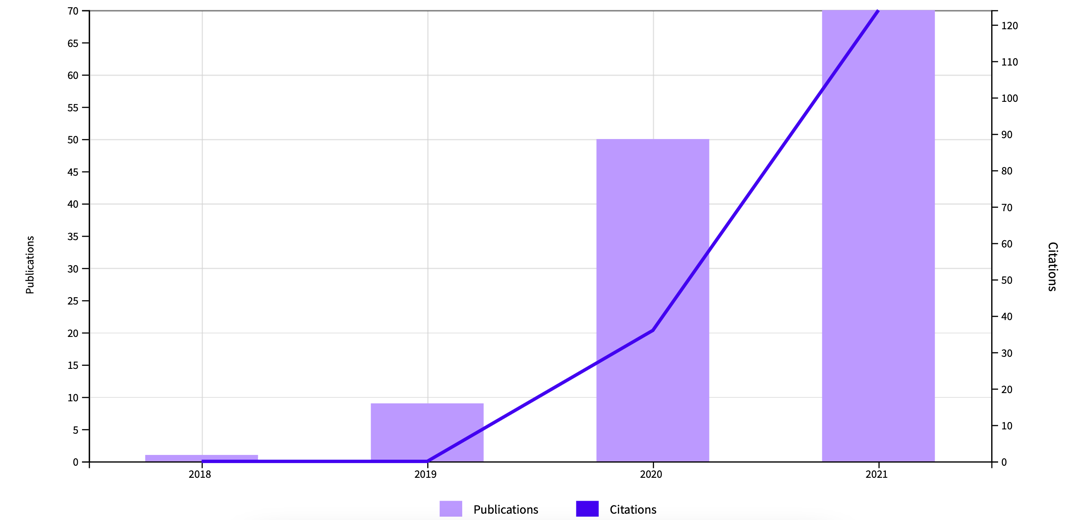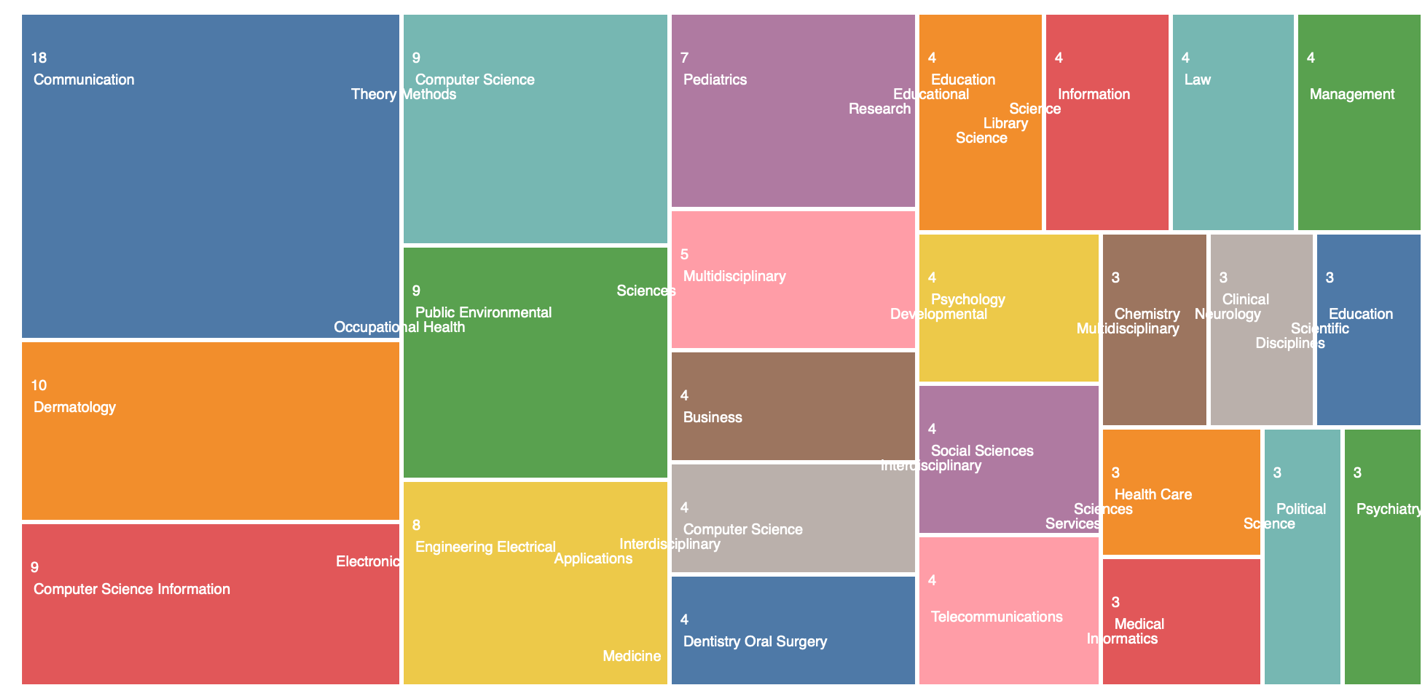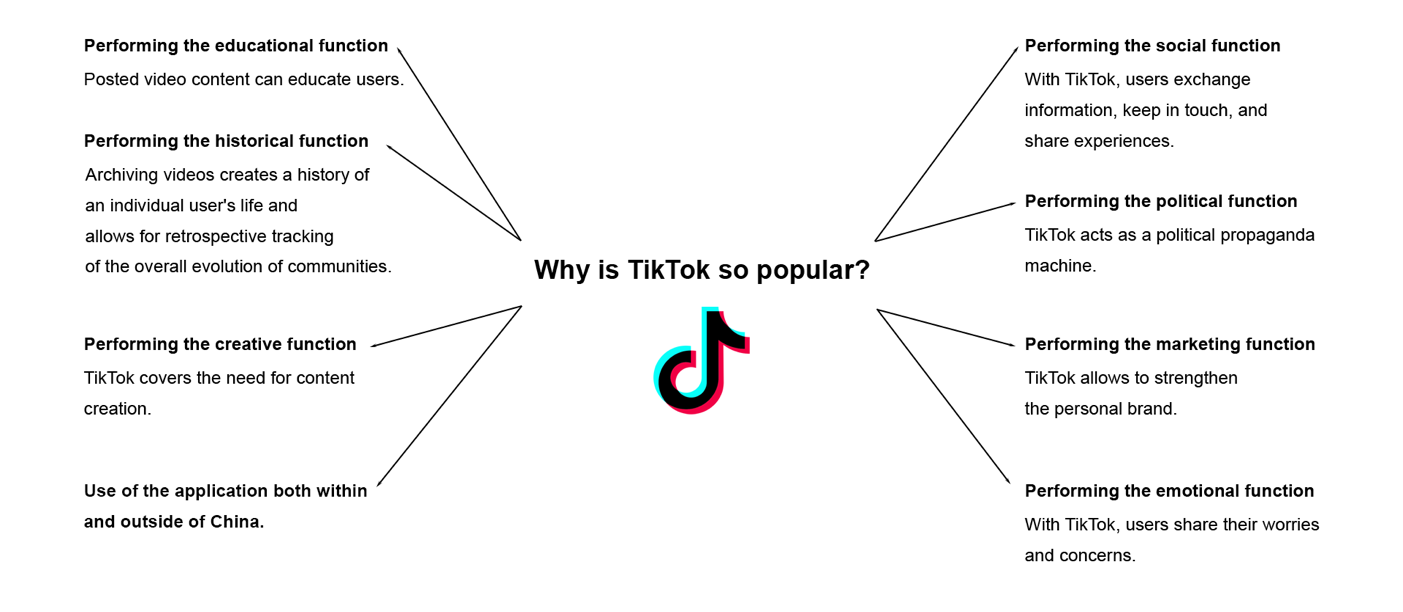The era of intensified globalization processes was catalyzed by the emergence of the large-scale Internet. The central goal of the creation of the Internet was originally the idea of forming a platform for easy access to all kinds of information. However, it is clear that with the development of global networks, this need could no longer be the only one: with access to knowledge, users rushed to establish contacts with other network participants (Bossen and Kottasz, 2020). Thus, the Internet, as noted by Anderson (2020), has not only become a tool for rapid access to knowledge from anywhere in the world but has also greatly facilitated social integration between members of different communities. Users from different cities, countries and even continents can communicate almost seamlessly using the global network to share information, borrow experiences, and, just as importantly, adopt the moral and cultural values of partner communities (Jian, 2018). Meeting such needs-led naturally to the formation of social networks as a platform for virtual user interaction.
Social media as units of a virtual community have the property of general evolution. Enough time has passed since the appearance of the first social networks, implemented through communication forums and personal blogs, and by the current moment, there is a noticeable trend toward the in-depth diversification of modern social networks. This is especially evident in the development of such platforms as Facebook, Instagram, and YouTube. In an attempt to get more attention from users and maintain a competitive advantage, platforms tend to diversify functionality and the appearance of different format content. For example, Facebook, initially designed for simple communication, has evolved into a video hosting, advertising platform, and online store through which users can buy real goods without leaving the site. However, it is a mistake to think that evolution is peculiar only to individual social networks. On the contrary, as shown in Kong, change is happening across the entire virtual platform industry, which is trying to match the interests of users better. Consequently, the birth of revolutionary new platforms that are not a synthesis of existing social networks but instead offer the virtual entertainment market a qualitatively new format is noticeable against the background of existing social networks. In particular, such a new-age social network is TikTok.
Beforehand, it is worth reviewing what exactly TikTok is and why this social network was able to achieve popularity around the world relatively quickly. The term “TikTok” is understood in the sense of Anderson (2020), in which the mobile app is evaluated as a creative virtual platform for encouraging the creative chaos that is a natural feature of the modern world. In a narrower sense, TikTok should be understood as a next-generation social network that meets the basic needs of users: pace, simplicity, and self-expression (Bossen and Kottasz, 2020). The high degree of correspondence between the features provided and the expectations of users has served as the impetus for the popularity of the Chinese app: TikTok has become “…the second most downloaded Android app worldwide… and the fifth most downloaded app worldwide from the Apple store” (Anderson, 2020, p. 9). In addition, according to Doyle (2021), TikTok’s monthly active audience exceeds one billion users, with the app itself having been downloaded over 2.6 billion times. The widespread popularity may also have been a social response to former U.S. President Donald Trump’s political remarks accusing the Chinese app of spying on the confidential data of international users (Gray, 2021). Although legally unproven, and in addition, with the arrival of Joe Biden, the charges against TikTok were dropped, this confident statement drew much attention to the app (Oxford Analytica, 2021; Leonard, 2021). Notably, the highest number of app downloads occurred during the first wave of the COVID-19 coronavirus pandemic, during which hundreds of millions of people around the world were quarantined (Kennedy, 2020). This phenomenon can be interpreted as the inability of users to ignore the fast-growing social network in the face of free time. In terms of functionality, TikTok is a video platform initially designed for the creation and viewing of short videos, usually no longer than fifteen seconds (Anderson, 2020). However, as previously stated, any social network undergoes changes to support users’ needs, so the length of posted videos has been extended over time to three minutes (Bossen and Kottasz, 2020). In a general summary, TikTok is a free, accessible mobile app — there is also a semi-functional version on the website — showing a high rate of audience growth.
It is legitimate to expect that the number of works critically assessing TikTok has skyrocketed in recent years. Turning to Figure 1 makes it clear that the first works mentioning the TikTok social network did not appear until 2018. This is only natural given the rebranding of the year in question, when ByteDance, a Chinese company that bought the unique rights to the then-existing format Musical.ly — TikTok’s predecessor — created a new, global social network (Anderson, 2020). Since then, the number of works mentioning this name has increased by 250%. Contrary to the expectation that the only categories of papers mentioning TikTok would be communication and sociological, Figure 2 provides an alternative picture: many papers on TikTok have been written within medical, computer science, and pedagogical research areas. All of this together leads to the conclusion that TikTok is a widely prevalent phenomenon not only among ordinary users but also within the academic community, trying to explore and use the fact of such an active mobile application.


However, such a high abundance of scientific papers, which is expected to continue the trend of capacity building, looks at TikTok from specific angles, measuring its potential to be used for specific practical tasks. This misses a critical phenomenon concerning the very essence of using the TikTok app: why do people around the world, regardless of their age, use TikTok, which forms the research question. The hypothesis critically evaluated in this literature review is that the use of TikTok allows users to express themselves creatively and find support among the vast community of the web through the multiple functional roles of the app. Based on this question, it is appropriate to differentiate the overall purpose of the review into separate subtopics:
- To gather scholarly materials that illuminate an issue of interest (TikTok).
- To carefully study the sources, conduct primary and secondary filtering.
- To summarize and synthesize the findings in this literature review.
- Based on the findings, to construct a conceptual map highlighting key findings.
The study of a large number of thematic papers in this literature review has legitimately led to the formation of the idea of the social multifunctionality of the TikTok application. More specifically, individual authors have explored specific operational issues related to, for example, COVID-19, user personality traits, or even the political aspects of the app (Basch, 2020; Omar and Dequan, 2020; Medina Serrano, 2020). All of this combined has led to the idea that TikTok is capable of performing several useful socio-educational functions at once, and this is one of the driving forces why users continue to use it.
Speaking of TikTok’s public health function, one should pay particular attention to the article ”COVID-19 on TikTok” by Basch, Hillyer, and Jaime. In this article, Basch et al. (2020) discuss the relationship between a pandemic and its reflection on a social network: through a review of videos posted on TikTok, the authors concluded that the social network allows audiences to share fears and worries. Basch et al. additionally found that using a hashtag system — tags in video descriptions or comments that allow videos to be systematized among others and found by tagging them — topics such as anxiety and quarantine were the most frequently discussed. As a result, this study showed that TikTok could be used by users to broadcast their own perceptions of the current world agenda. These findings are perfectly supported by a more recent study by Li et al. (2021), who measured similar trends on a larger sample of videos. More specifically, Li et al. (2021) noted TikTok as a central mouthpiece for virtual social broadcasting in the COVID-19 context, allowing users to not only receive real-time updates — including via a built-in “About COVID-19” button — but also to share personal experiences and doubts about it. The authors especially emphasize that such trends have a tendency to grow, and therefore already now TikTok should not be ignored by departmental agencies: with the help of the platform, it becomes possible to monitor public sentiment and conduct propaganda.
Similar conclusions were valid for a study that evaluated the political component of the social network. In more detail, Medina Serrano et al. (2020) showed that the integration of political contexts into this social network is much deeper than for other mobile apps due to the tree-like structure of interaction between users. Thus, TikTok’s functional ability to respond to a specific video with its own videos — a so-called duet — forms the structure of the tree, making the political learning of users deeper and more critical. Briefly and precisely, the essence of TikTok’s educational function is defined by Hayes et al. (2020), who confirmed the possibility of academic integration into video viewing. Through an online course conducted on the social networking platform, respondents were able to learn new knowledge about the chemical sciences as well as visualize its practical applicability. This leads to the conclusion that the learning objective is appropriate and acceptable for use through the TikTok platform.
An additional functional category of the TikTok network, namely the establishment of social communication, is revealed in the diversity of research. The COVID-19 era, according to Su et al. (2020), was an excellent opportunity for media personalities not only to have their own TikTok account but also to establish effective communication with subscribers. More specifically, Su et al. (2020) demonstrated the potential for strengthening fan connections, maintaining a personal brand, and staying relevant to young athletes. Similar thoughts were the basis of a study by Mittmann et al. (2021), who evaluated TikTok as part of the global online engagement of early adolescents. According to Mittmann et al. (2021), the integration of TikTok into today’s community of young people is so great that the use of TikTok for communication acquires dangerous tendencies to virtualize the lives of members of the new generation. However, it is not difficult to see an important message in these statements: the TikTok platform can be used as a marketing tool for the personal promotion of bloggers and public figures. The most acceptable evidence for this assumption was found in Haenlein et al. (2020), who evaluated virtual growth strategies in social media, including TikTok. The authors showed the need for cross-platform integration of content and support of personal brand relevance through a presence in new platforms unambiguously defines TikTok as a necessary element for personal brand promotion. Consequently, the marketing and social function of TikTok cannot be ignored when considering the overall popularity of the app.
A new streak in research on the functional scope of TikTok is being acquired in works devoted to personal motivations for using the network. In this context, it is legitimate to cite a comprehensive review by Omar and Dequan (2020), who assessed the needs of the target audience in using this social network. In general, the authors showed that the desire for creative self-expression, reinforcing one’s own social importance, and archiving one’s life through video content are the primary motivating forces that make users sign up online (Omar and Dequan, 2020). The findings are consistent with those of Mittmann et al. (2021), who demonstrated the natural need of early adolescents to communicate virtually with people other than people they know. Such discussions together lead to the logical conclusion that the TikTok social network satisfies the user’s deep, sensual need for personal socialization.
To conclude this literature review, it is especially worth highlighting some of the stigmatization of TikTok that has been noticed in the selection of sources. More specifically, for a number of academic papers, this social network has been firmly associated with “dancing,” “lip-syncing,” or “pretty young girls” (Medina Serrano et al., 2020; Kennedy, 2020). While these categories may indeed be encountered on the platform, their synonymous use in conjunction with TikTok severely limits the potential social relevance of this app. At the same time, both academia and the public tend to view TikTok as a social network for teens, lacking the seriousness and thoroughness for use by adults. Statistics show an alternative agenda. According to Aslam (2021), no more than 50% of users are from the younger generation under 34, while the remaining participants are from Generation Y, Generation X, and even baby boomers. In terms of the gender gap, no significant differences were found, with 53% of users being male and 47% female (Aslam, 2021). As has been shown in this literature review, TikTok has a plurality of functional roles. Meeting each user’s individual, superficial, and deep needs keeps them as customers of the social network and attract new ones. Thus, as it has been shown, TikTok is a top-rated social interaction platform for users to communicate through video content. As an overall result of the review, a conceptual model of the study was created, highlighting the key findings of the source study.

Reference List
Aslam, S. (2021) TikTok by the numbers: stats, demographics & fun facts.
Anderson, K. E. (2020) ‘Getting acquainted with social networks and apps: it is time to talk about TikTok,’ Library Hi Tech News, 37(4), pp. 7-12.
Basch, C.H., Hillyer, G.C. and Jaime, C. (2020) ‘COVID-19 on TikTok: harnessing an emerging social media platform to convey important public health messages,’ International journal of adolescent medicine and health, x(x), pp. 1-12.
Bossen, C.B. and Kottasz, R. (2020) ‘Uses and gratifications sought by pre-adolescent and adolescent TikTok consumers,’ Young Consumers, 21(4), pp. 1-33.
Doyle, B. (2021) TikTok statistics – updated June 2021.
Gray, J. (2021) ‘The geopolitics of ‘platforms’: the TikTok challenge,’ Internet Policy Review, 10(2), pp. 1-18.
Haenlein, M., Anadol, E., Farnsworth, T., Hugo, H., Hunichen, J. and Welte, D. (2020) ‘Navigating the new era of influencer marketing: how to be successful on Instagram, TikTok, & Co,’ California Management Review, 63(1), pp. 5-25.
Hayes, C., Stott, K., Lamb, K.J. and Hurst, G.A. (2020) ‘“Making every second count”: utilizing TikTok and systems thinking to facilitate scientific public engagement and contextualization of chemistry at home,’ Journal of Chemical Education, 97(10), pp. 3858–3866.
Jian, Z. (2018) ‘Research on cultural diversity and intercultural communication under the new media environment,’ International Conference on Social Sciences, Modern Management and Economics, pp. 63-67.
Kennedy, M. (2020) ‘‘If the rise of the TikTok dance and e-girl aesthetic has taught us anything, it’s that teenage girls rule the internet right now: TikTok celebrity, girls and the Coronavirus crisis,’ European Journal of Cultural Studies, 23(6), pp. 1069-1076.
Kong, Q., Mao, W., Chen, G. and Zeng, D. (2018) ‘Exploring trends and patterns of popularity stage evolution in social media,’ IEEE Transactions on Systems, Man, and Cybernetics: Systems, 50(10), pp. 3817-3827.
Leonard, J. (2021) Biden revokes Trump-era TikTok and WeChat bans.
Li, Y., Guan, M., Hammond, P. and Berrey, L.E. (2021) ‘Communicating COVID-19 information on TikTok: a content analysis of TikTok videos from official accounts featured in the COVID-19 information hub,’ Health Education Research, pp. 1-12.
Medina Serrano, J.C., Papakyriakopoulos, O. and Hegelich, S. (2020) ‘Dancing to the partisan beat: the first analysis of political communication on TikTok,’ ACM Conference on Web Science, pp. 257-266.
Mittmann, G., Woodcock, K., Dörfler, S., Krammer, I., Pollak, I. and Schrank, B. (2021) ‘“TikTok is my life and Snapchat Is My Ventricle”: a mixed-methods study on the role of online communication tools for friendships in early adolescents,’ The Journal of Early Adolescence, pp. 1-32.
Omar, B. and Dequan, W. (2020) ‘Watch, share or create: the influence of personality traits and user motivation on TikTok mobile video usage,’ International Association of Online Engineering, 14(4), pp. 121-137.
Oxford Analytica (2021) ‘Biden’s TikTok-WeChat review will calm Beijing,’ Emerald Expert Briefings, x(x), pp. 1-4.
Su, Y., Baker, B.J., Doyle, J.P. and Yan, M. (2020) ‘Fan engagement in 15 seconds: athletes’ relationship marketing during a pandemic via TikTok,’ International Journal of Sport Communication, 13(3), pp. 436-446.